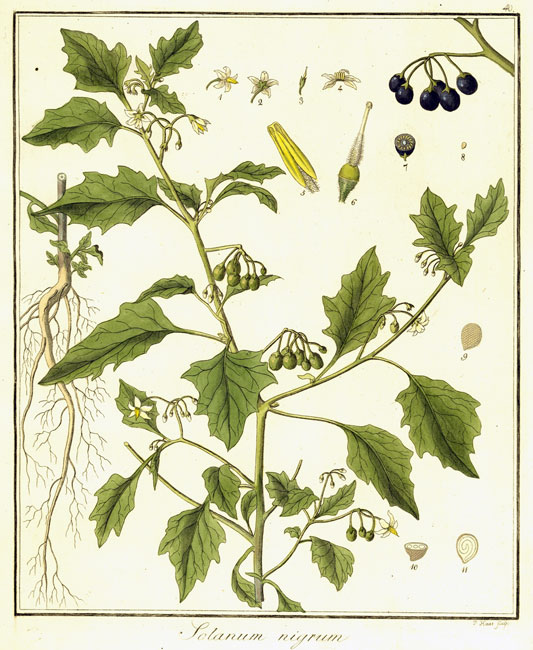
Scientific Name Solanum nigrum
Common Name European Black Nightshade, Garden Nightshade, Hound’s Berry
Botanical Family Solanaceae
Joan Clayton points out Solanum nigrum and tells Vanessa to remember it (S2E3, 15:29). It is yet another Nightshade mentioned in the show, and is native to Eurasia, but has been introduced in the Americas, Australia, and South Africa. It is a common herb, or short-lived perennial shrub found in many wooded areas. Sometimes the flower of S. nigrum can be confused with Atropa belladonna, or the deadly nightshade. The photo on the left is S. nigrum while the photo on the right is Atropa belladonna. When Vanessa walks the botanical gardens with Dorian Gray, he shows her an Atropa belladonna plant, which Vanessa is shocked to hear is very poisonous. She was most likely feigning ignorance about the flower around Mr. Gray, for she surely learned all about the Nightshade family from Joan Clayton.
Despite some forms and parts of the plant being toxic, the berries of S. nigrum have been eaten and used in the culinary arts for several hundred years. The fruit was recorded as a famine food in 15th century China. The ripe black berries are described as sweet and salty, with hints of liquorice and melon. Many different cultures all around the world prepare and eat the berries of the plant.
The plant also has a long history of medicinal usage, dating back to ancient Greece, where is was used to help cure dropsy, or edema. It is a traditional European medicine, mainly used as a strong narcotic and sedative. It is also an important medicinal flower in Indian medicine, as infusions were used to treat dysentery, stomach complaints, and fever. Like with Mandragora, Dioscorides recorded uses S. nigrum as well, including headache, heartburn, skin inflammation, venereal disease, and “womanish flux”.
References
Defelice, Michael S. (2003). “The Black Nightshades, Solanum nigrum L. et al.–Poison, Poultice, and Pie”. In Intriguing World of Weeds, Vol. 17. pp. 421-427.

